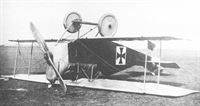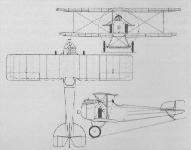W.Green, G.Swanborough The Complete Book of Fighters
AVIATIK (BERG) 30.14 Austria-Hungary
The first single-seat fighter to be built by the Osterreichisch-Ungarische Flugzeugfabrik Aviatik to the designs of Dipl Ing Julius von Berg, the Aviatik 30.14 (the designation indicating the 14th experimental aircraft produced by O-UF Aviatik) was powered by a 185 hp Austro-Daimler six-cylinder inline water-cooled engine. Armament consisted of a single 8-mm Schwarzlose synchronised machine gun. Of wooden construction with ply and fabric skinning, the Aviatik 30.14 crashed at Aspern on its first flight on 16 October 1916, the test pilot, Ferdinand Konschel, losing his life. However, the programme had revealed sufficient promise to warrant further development of the basic design, The wing gap was drastically reduced, wing stagger was introduced, the vertical tail surfaces were enlarged and, with more minor changes, three further prototypes were built, the 30.19, 30.20 and 30.21, which led to the DI.
Max speed, 109 mph (175 km/h).
Span, 26 ft 3 in (8,00 m).
Length, 22 ft 6 in (6,86 m).
P.Grosz, G.Haddow, P.Shiemer Austro-Hungarian Army Aircraft of World War One
Aviatik 30.14
The 30.14 prototype is significant in that it was the first fighter designed and built entirely in the Dual Monarchy. On 8 June 1916, Berg proposed to the LFT a biplane fighter powered by a 160 hp Daimler engine, armed with a fixed machine gun, and having a calculated top speed of 185 km/h (115 mph). Concurrently, Berg also proposed a light reconnaissance monoplane powered by a 120 hp Daimler engine. Neither project was approved by Flars because Aviatik was barred from engaging in prototype work in order devote full effort to the Knoller program. When Uzelac got wind of the fighter project in August 1916, he fortunately intervened to support the Aviatik proposal.
Construction of the 30.14 fighter prototype started in August. The uncovered airframe was inspected on 26 September by Flars engineers who listed various shortcomings for correction, especially strengthening the steering controls and flying surfaces. On 16 October 1916, the 30.14 stood ready for its maiden flight at Aspern. It was a clean biplane of pleasing lines, marred only by the tail assembly which appears undersized in relation to the airframe. The high center-section struts provided an unobstructed field of view. It was the first step towards the more compact D.I fighter, to which it bore an unmistakable family resemblance.
Feldwebel Ferdinand Konschel, an experienced Flars test pilot, was carefully briefed for the maiden flight. Ingenieur Julius Kolin recalled warning Konschel to exercise caution, but his counsel was shrugged off by Berg. According to Kolin's theoretical calculations, Berg's experimental airfoil could demonstrate an extreme center of pressure shift under certain flight conditions. Berg had adopted a Knoller-type airfoil whose rib section had a pronounced reflex curvature at the very narrow trailing-edge section. Although the airfoil was judged efficient for high speeds, little was known about its low speed and stall characteristics.
In the face of unpredictable wind gusts, Konschel had intended to perform only a few preparatory hops. Witnesses reported that after some 30 meters of low hops, Konschel unexpectedly lifted off - involuntarily according to some. With the engine at low rpm, he wove a wobbly flight path and executed a flat turn at 100 meters height. As Konschel throttled back to land, the prototype plunged straight into the ground. The crash protocol blamed Konschel's death on "a nose-heavy aircraft and inadequate control surfaces." The official inquest, however, attributed the crash to control-pulley failure. Nevertheless, Kolin remained certain that the center of pressure shift was the real culprit. With Knoller's assistance, Kolin designed a new airfoil for use on future Aviatik aircraft. Though beset by misfortune, the 30.14 prototype was the progenitor of the Aviatik D.I fighter that remained in service until the end of the war.
Aviatik 30.14 (Single-Seat Fighter) Specifications
Engine: 160 hp Daimler
Wing: Span Upper 8.00 m (26.25 ft)
Chord Upper 1.60 m (5.25 ft)
Chord Lower 1.50 m (4.92 ft)
General: Length 6.86 m (22.51 ft)
Loaded Weight 715 kg (1577 lb)
Aviatik 30.19, 30.20, and 30.21
On 25 September 1916, Flars approved three fighter prototypes based on the 30.14 design and incorporating some 40 improvements specified by Flars. Three prototypes, designated Aviatik 30.19 to 30.21, were built; one for flight evaluation, one for static tests, and one as a spare. Aviatik was directed to proceed with all possible speed.
Originally scheduled to start flight tests in November 1916, the 30.19 airframe inspection by Flars was delayed until 28 December, and the maiden flight took place on 24 January 1917. The Aviatik 30.19, prototype for the Aviatik D.I, here retro-fitted with a one-piece upper wing, during flight evaluation at Aspern.
LFT pilots were cleared to fly the 30.19, powered by a 185 hp Daimler engine, on 13 February. Flars test pilot Oberleutnant Oskar Fekete reported on 31 March 1917 that the 30.19 had flight characteristics similar to the Aviatik C.I but was superior all around. Fie emphasized the fighter's "fabulous climb and enormous maneuverability" and felt that any competent two-seater pilot should be able to fly the type without prior schooling. On 15 May 1917, the 30.19 prototype (retro-fitted with a one-piece upper wing) and the first production Aviatik D.I, 38.01 were dispatched to Fluggeschwader I (later renamed Flik 101/GJ on the Isonzo Front for evaluation under frontline conditions. Armed with a free-firing machine gun mounted on the upper wing, the 30.19 was flown at the Front by Hauptmann Karl Sabeditch from 18 May until July 1917, when it was badly damaged and written-off. On 23 May 1917, Sabeditch downed a Caproni bomber, thereby achieving the first victory both for himself and an Aviatik fighter aircraft (30.19).
The 30.20 prototype failed the load test on 17 March. A one-piece wing was designed to replace the two-piece upper wing and cabane center-section. As soon as the 30.20 passed the third load test on 28 April 1917, the design was released for production as the Aviatik D.I series 38 fighter. The 30.20 prototype was written-off after the load tests.
The 30.21 was used for flight trials until February 1917, when, after a minor landing mishap, the airframe was modified by Aviatik as the prototype for the Aviatik D.II and renumbered 30.22.
Aviatik 30.19 Specifications
Engine: 185 hp Daimler
Wing: Span Upper 8.00 m (26.25 ft)
Span Lower 7.84 m (25.72 ft)
Gap 1.35 m (4.43 ft)
General: Track 1.80 m (5.91 ft)
Aviatik 30.20 Specifications
Engine: 185 hp Daimler
Wing: Span Upper 8.00 m (26.25 ft)
Span Lower 7.92 m (25.98 ft)
Chord Upper 1.45 m (4.76 ft)
Chord Lower 1.30 m (4.27 ft)
Dihedral Upper 0 deg
Dihedral Lower 0 deg
Sweepback Upper 0 deg
Sweepback Lower 0 deg
Gap 1.35 m (4.43 ft)
Stagger 0.25 m (0.82 ft)
Total Wing Area 20.4 sqm ( sq ft)
General: Length 6.86 m (22.51 ft)
Height 2.50 m (8.20 ft)
Track 1.80 m (5.91 ft)
Empty Weight 734.5 kg (1620 lb)
Loaded Weight 854.5 kg (1884 lb)
E.Hauke, W.Schroeder, B.Totschinger Die Flugzeuge der k.u.k. Luftfahrtruppe und Seeflieger 1914-1918
30. Flugzeuge der Österreichischen Aviatik-Werke Wien, Stadlau
30.14 Aviatik DD (Jagdtype) Dm 160
30.19 Berg D Prototyp für D.I Dm 185
30.20 Berg D Prototyp für D.I Dm 185
30.21 Berg D Prototyp für D.I Dm 185
 |
E.Hauke, W.Schroeder, B.Totschinger - Die Flugzeuge der k.u.k. Luftfahrtruppe und Seeflieger 1914-1918
|
| Aviatik D.I-Prototyp
|
 |
E.Hauke, W.Schroeder, B.Totschinger - Die Flugzeuge der k.u.k. Luftfahrtruppe und Seeflieger 1914-1918
|
| Aviatik D-Prototyp (30.19 ???)
|
 |
E.Hauke, W.Schroeder, B.Totschinger - Die Flugzeuge der k.u.k. Luftfahrtruppe und Seeflieger 1914-1918
|
| Aviatik-Berg D 30.21 Prototyp für D I Aspern März 1917
|
 |
P.Grosz, G.Haddow, P.Shiemer - Austro-Hungarian Army Aircraft of World War One /Flying Machines/
|
Feldwebel Ferdinand Konschel posing with the Aviatik 30.14 prototype shortly before his fatal crash on 16 October 1916.
The first Austrian Aviatik fighter prototype, the 30.14 which crashed in October 1916.
|
 |
P.Grosz, G.Haddow, P.Shiemer - Austro-Hungarian Army Aircraft of World War One /Flying Machines/
|
The Aviatik 30.19, prototype for the Aviatik D.I, here retro-fitted with a one-piece upper wing, during flight evaluation at Aspern.
Aviatik 30.19, Prototyp für Berg D.I. Aspern Mai 1917, im Juni zur Fronterprobung beim FIG I
Aviatik 30.19, прототип Berg D.I. Асперн, май 1917 г., фронтовые испытания в июне в FIG I.
|
 |
P.Grosz, G.Haddow, P.Shiemer - Austro-Hungarian Army Aircraft of World War One /Flying Machines/
|
| The Aviatik 30.21 was slightly damaged at Aspern in the course of testing. It was subsequently rebuilt with a wireless wing cellule and redesignated 30.22, to become the prototype of the Aviatik D.II.
|
 |
W.Green, G.Swanborough - The Complete Book of Fighters
|
| Julius von Berg's first fighter, the 30.14.
|
 |
P.Grosz, G.Haddow, P.Shiemer - Austro-Hungarian Army Aircraft of World War One /Flying Machines/
|
| Aviatik 30.14
|









